Ghanaian baby from top of border wall by migrant smuggler [VIDEO]
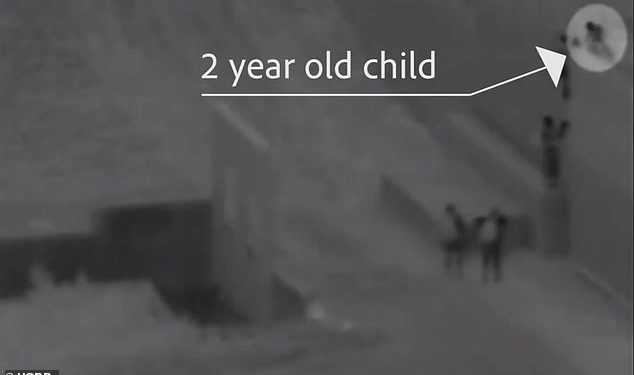
A smuggler helping illegal immigrants cross into the United States from Mexico dropped a two-year-old Ghanaian child from atop an 18ft wall into the arms of the father who was waiting below.
Dramatic video footage taken by the US Border Patrol shows a group of people climbing over the wall along the boundary near Imperial Beach, California, just outside of San Diego, after midnight on Sunday.
Surveillance footage shows several individuals scaling the wall. At one point, a two-year-old child was dangled from atop the barrier.

The child was then dropped into the arms of the father below. There were no injuries.
A short time later, Border Patrol agents arrested the group. The agency did not specify how many people were involved.
‘This event could have been catastrophic,’ Border Patrol Agent Aaron M. Heitke told KGTV-TV.
‘It is not only unlawful, but inherently dangerous to cross the border anywhere outside of a designated port of entry.’
It was later learned that the child and the father are citizens of Ghana.
In 2019, American and Mexican officials reported a record number of African migrants arriving at the US border.
In all of fiscal year 2018, a total of 211 African migrants who were detained by the US Border Patrol along the entire 2,000-mile frontier with Mexico.
The next year, US border authorities arrested more than double that number in one week alone.
In 2019, Mexican authorities reported that they had detained more than 7,000 migrants from Africa who were seeking to eventually cross into the US.
A large number of these migrants were from war-torn countries including Cameroon, the Democratic Republic of the Congo, and Somalia.
They are coming to America after flying across the Atlantic Ocean to South America and then embarking on an often harrowing overland journey.
The explosion in immigration to the US from sub-Saharan Africa coincides with a steep drop in the migration flow across the Mediterranean to Europe after European countries and two main embarkation points – Turkey and Libya – decided to crack down.
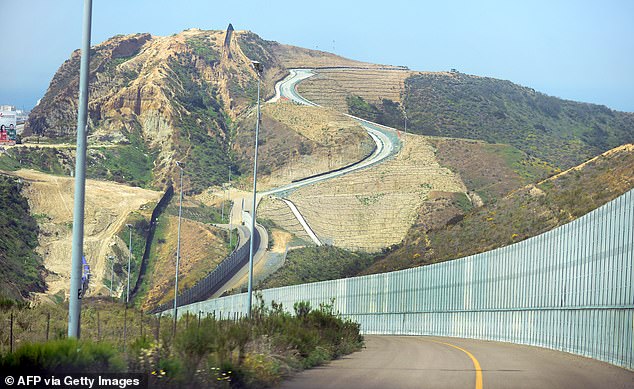
From January 1 to June 12, 2019, only 24,600 migrants arrived in Europe by sea, compared to 99,600 over the same period in 2017, according to the International Organization for Migration.
Most of these migrants were stranded in Mexico after then-President Donald Trump threatened to impose tariffs on America’s southern neighbor if it did not stem the flow of people seeking asylum.
A day after the incident at Imperial Beach, Texas border agents discovered 20 undocumented immigrants, including two children, attempting to enter the US while hiding under the boards of a trailer.
On Wednesday, Vice President Kamala Harris announced she will travel to Mexico and Guatemala as the migrant crisis at the border deepens.
Chief Patrol Agent Austin Skero shared images of the smuggling attempt that showed 18 adults and two children lying on top of one another under the boards.
Skero confirmed that the children’s ages are 10 and 15. It’s unclear if they were traveling alone, with their parents or with other relatives.
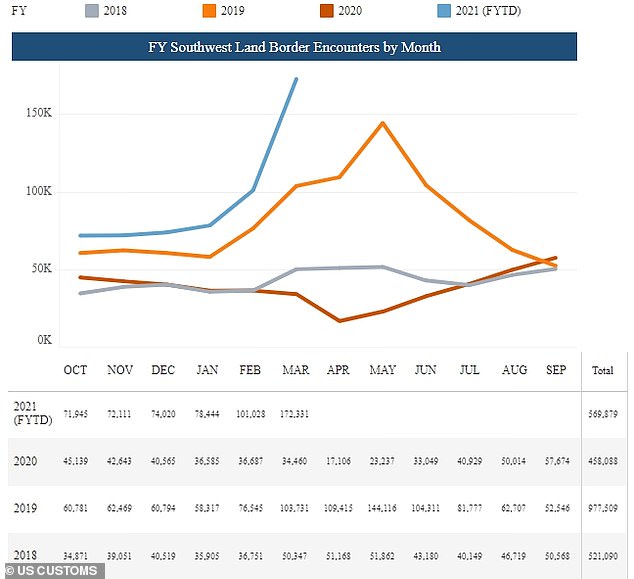
Another image shows massive bags and other items that were placed on top of the boards to conceal the migrants.
Skero said they made the discovery after a Del Rio Sector K9 alerted agents to the trailer at one of their checkpoints.
‘With temperatures on the rise, smuggling attempts like these have a high potential to turn deadly,’ Skero said.
It’s also unclear where exactly they were traveling from.
A DailyMail.com request for comment and more information to US Customs and Border Protection (CBP) was not immediately returned Wednesday morning.
Harris said she’ll visit Mexico and Guatemala but won’t go to the southern border and the overcrowded child migrant camps because Homeland Security Secretary Alejandro Mayorkas is in charge of that aspect of the crisis.
She defended her move in a Zoom meeting with northern triangle country experts, 21 days after the White House named her the border ‘czar’.
‘The President has asked Secretary Mayorkas to address what is going on at the border,’ she clarified to the press before kicking off the closed-door meeting. ‘I have been asked to address the root causes.’
There were nearly 170,000 encounters with migrants on the US-Mexico border in March, a 20-year high. The total, announced Thursday, includes nearly 19,000 children traveling alone, the highest monthly number on record.
About four in 10 border encounters last month were with families and unaccompanied children – many from Guatemala, Honduras and El Salvador – at a time when policies in the US and Mexico favor them staying in the United States while they seek asylum.
It marks the third sharp jump in Central American asylum-seekers in seven years.
One child who made national headlines is Wilton Obregón. Wilton was captured on video tearfully asking a CBP agent for help earlier this month.
His family left Nicaragua for the US on February 8. Wilton and his mother, Meylin, illegally crossed the Mexico-US border in late March and were intercepted by border agents before they were forced to return back to Mexico.
Wilton and his mother were then kidnapped an hour after arriving in Mexico.
Their abductors then contacted her brother Misael Obregón in Miami requesting ransom, but he was only able to gather enough money to secure his nephew Wilton’s freedom. After Wilton was released from his captors, he was able to again cross into the United States with more than 100 people.
But he was left behind in the middle of the night while napping in the Texas desert area. On April 1, a CBP officer who was on his way home after concluding his work shift encountered Wilton in the middle of a dirt road in the Texas border city of La Grulla.
A video recorded by the agent captured the moment Wilton went up to him crying and asking for help.
‘It’s that I was coming with a group and they abandoned me and I do not know where they are at,’ the child told the officer in Spanish.
Later the border agent asked the boy if he had been instructed ‘to come ask for help,’ but the the child replied, ‘no, I am coming because if I did not, where am I going to go? Somebody could abduct me, kidnap me. I am scared.’
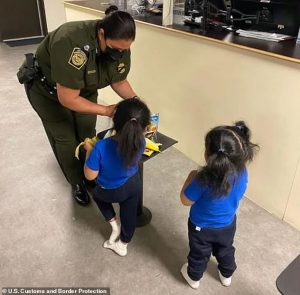
These encounters have been occurring more often as the US tries to grapple with the border crisis.
In another incident, two Ecuadorean girls were abruptly dumped over a steel barrier at the Mexico-United States border on March 30.
Surveillance video footage released by Border Patrol showed the moment a smuggler dropped Yareli, three, and her five-year-old sister Yasmina over the 14-foot high border wall in New Mexico.
Another smuggler was waiting on the American side to catch the girls, who were then tossed to the ground. Both smugglers then fled, abandoning the children.
The surveillance camera operator immediately alerted Santa Teresa Border Patrol Station agents and directed them to the remote location.
The girls’ mother, Yolanda Macas Tene, and father, Diego Vacacela Aguilar, had left their Ecuadorean home not long before, relatives said, and were awaiting their daughters in New York City.
An official with the Consulate of Ecuador told DailyMail.com that the girls could soon be reunited with their parents in New York City.
The latest jump in border crossings follows ferocious storms in Central America and President Joe Biden ending former president Donald Trump’s hardline immigration policies, though many changes attributed to Biden are rumors or have been fabricated by smugglers to generate business.
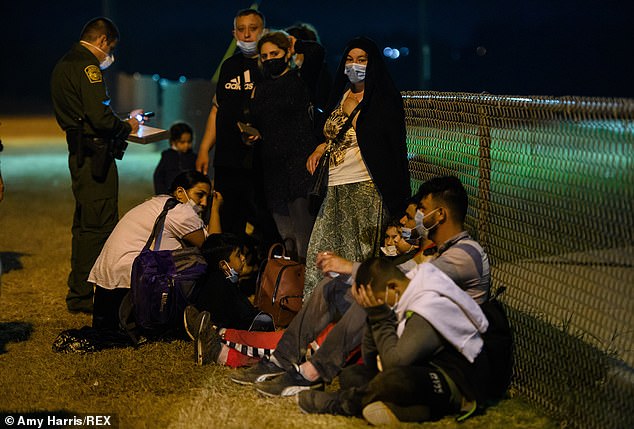
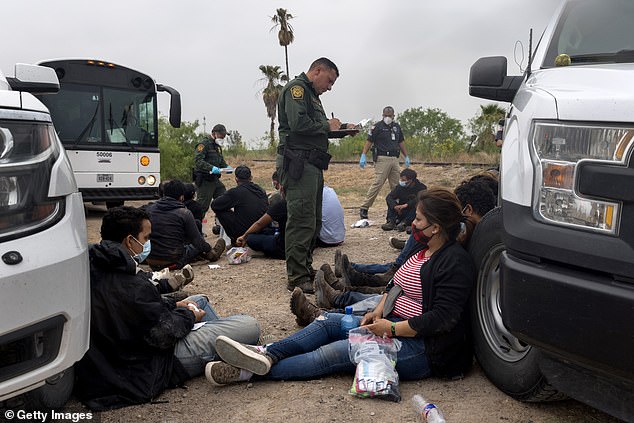
The ‘root causes’ prompting Central Americans to leave haven’t changed, said Sister Norma Pimentel, executive director of Catholic Charities of the Rio Grande Valley in Texas, whose temporary shelter has been hosting 400 to 500 people nightly, compared with a peak of about 1,000 in 2019.
‘I think that it’s simply that the traffickers use whatever is happening in the United States to extort the families, to lure them, to create a narrative that says, ‘Come right now. The president is going to let you in,” she said.
Migrants, in dozens of interviews over the last two weeks, generally said circumstances in Central America led them to the US. When asked about Biden, nearly all said his relatively pro-immigration positions influenced their thinking.
Smuggling fees vary widely, with some paying up to $10,000 a person in the Rio Grande Valley, the busiest corridor for illegal crossings.
There is often a discount for additional relatives. The trip can take weeks in cars, buses and trucks, ending when an inflatable raft reaches the banks of the Rio Grande and families and children turn themselves in to Border Patrol agents.
Biden has exempted unaccompanied children from expulsion, allowing them to stay in the US while pursuing asylum claims and live with ‘sponsors,’ usually parents or close relatives.
Harris and Biden both have been hammered by GOP lawmakers for not visiting the border, even as jarring photos of minors held in overcrowded detention centers drew fresh attention to the issue.
Biden has dispatched a number of top aides to evaluate the situation at the border instead.
Republican lawmakers returning from a border trip blamed the Biden administration for the problems, arguing for a return to Trump-era policies. They said the president and vice president need to go to the border to see firsthand the migrant surge.
‘He can stop this today,’ said Rep. Steve Scalise, R-La., the GOP whip. ‘Vice President Harris needs to go down to the border and see this for herself.’
Harris faces her own set of challenges in taking on a problem that has long eluded any easy solutions.
She’s been tasked with overseeing diplomatic efforts to deal with issues spurring migration in the Northern Triangle countries of El Salvador, Guatemala and Honduras, which includes pressing them to strengthen enforcement on their borders, while also developing and implementing a long-term strategy that gets at the root causes of migration from those countries.
On Wednesday, Harris was led a briefing with a handful of experts focused on those very issues, and she acknowledged in remarks to reporters that solving the region’s problems would take time.
‘We have to figure out how to assess our impact,’ she said, but added, ‘it will not be obvious overnight’.
‘The work we have to do is going to require a commitment that is continuous, that we institutionalize with our partners,’ and that includes a long-term strategy in the region, Harris said.
She added: ‘It will take some time to see the benefits of that work, but it will be worth it.’




